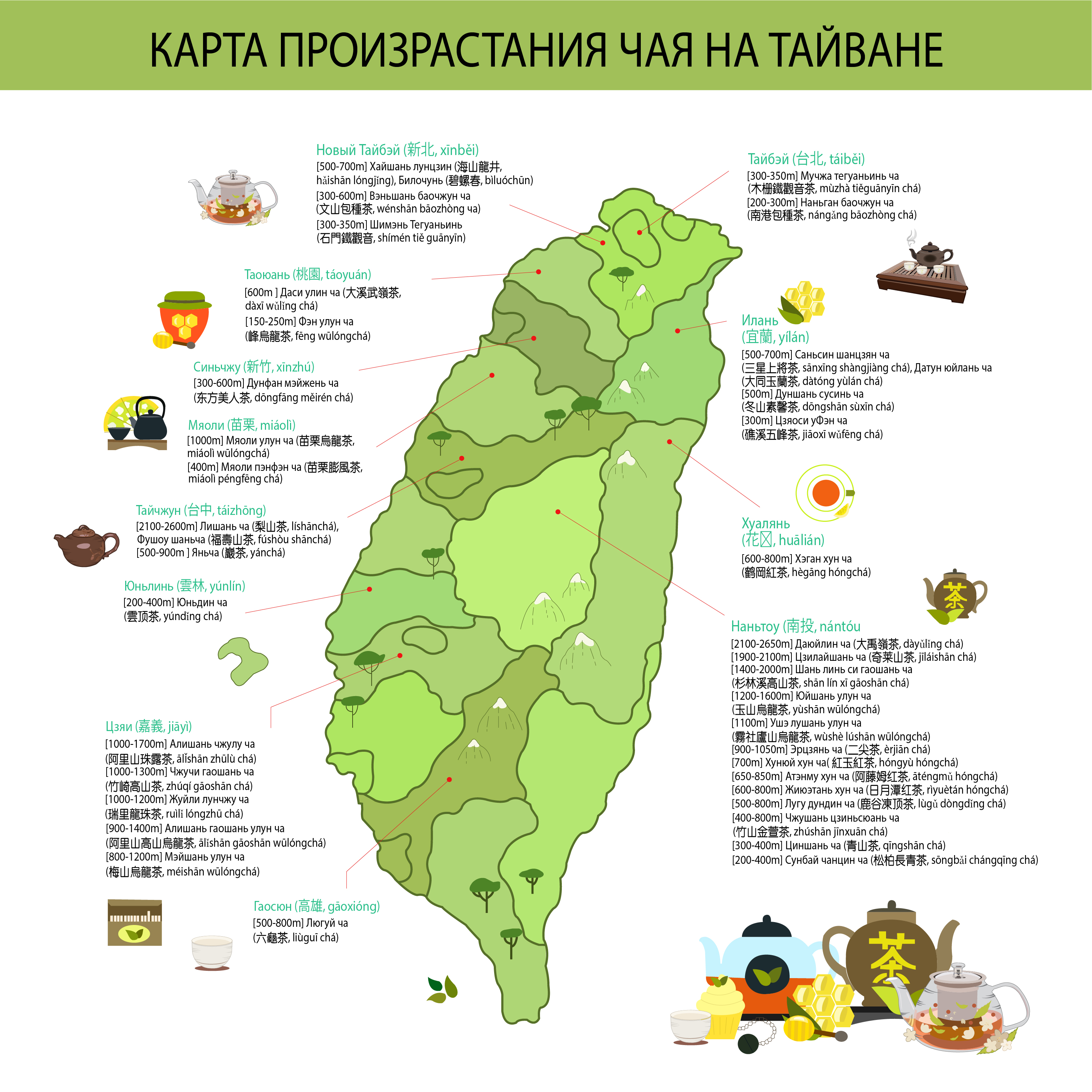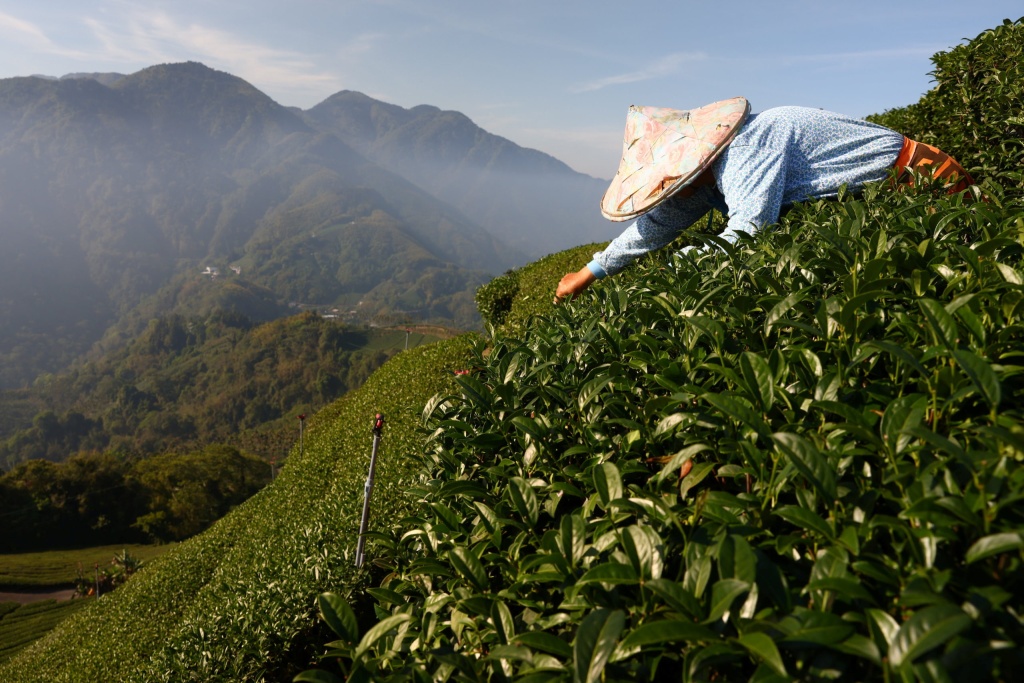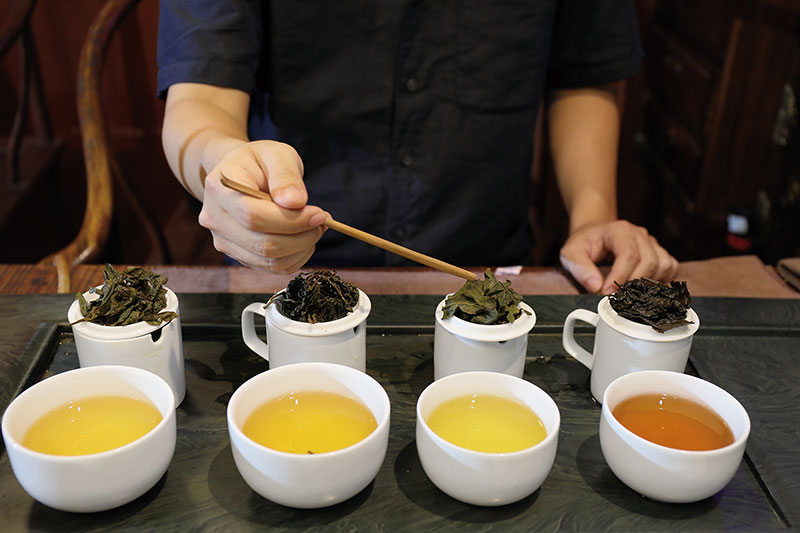Tea Producing Regions in Taiwan
On Taiwan Island, tea regions extend from north to south and from west to east. The main tea production areas are Taipei, Taoyuan, Hsinchu, Miaoli, Taichung, Nantou, Yunlin, Chiayi, Kaohsiung, Taitung, Hualien and Yilan.

1. Songbai Tea District (Chinese: 松柏茶区 pinyin Sōngbǎi chá qū). The Songbai Tea District is located at an altitude of about 500 meters in the Mingjian District (Chinese: 名间, pinyin Míng jiān) of Nantou County (Chinese: 南投县, pinyin Nántóu xiàn). It was previously one of the main oolong tea producing areas in Taiwan. A large amount of raw materials are collected in this area, harvesting is carried out mainly mechanically. Particular attention is paid to the production process and equipment. The tea leaves are distinguished by a fresh aroma with light sweet notes.
2. Dongding Tea District (Chinese: 冻顶茶区 pinyin Dòng dǐng chá qū). Dongding Tea District is located at an altitude of about 900 meters, in Lugu, Nantou County (Chinese: 南投县鹿谷 pinyin Nántóu xiàn lùgǔ). It is the most famous and largest production site of charcoal-roasted oolong tea in Taiwan. It is also the most famous site of tea competitions in Taiwan, which are held in spring and winter, attracting various tea farmers. Dongding Mountain is located at an altitude of 743 meters above sea level, and is covered with clouds and fog all year round. The soil is very rich in trace elements favorable for growing tea bushes. The most famous tea from this area is a fire-roasted tea that people call "kung fu tea" (Chinese: 功夫茶, pinyin: Gōngfūchá) or "old man's tea" (Chinese: 老人茶, pinyin: Lǎorén chá). Due to its lower caffeine content, it is a very mild stimulant and has little effect on sleep.
3. Alishan Tea District (Chinese: 阿里山茶区, pinyin: Ālǐ shānchá qū). Alishan is located at an altitude of about 1,500 meters above sea level in Shidao, Jiayi County (Chinese: 嘉义县石桌, pinyin: Jiāyì xiàn shí zhuō), and is the most famous tea export district. This area mainly produces semi-fermented oolong tea. Tea leaves grown in the Alishan area are soft, thick, with a characteristic vital shine. Separately, we can highlight the Jin Xuan oolong tea (Chinese: 金萱茶 pinyin, Jinxuan), which has a soft and elegant taste with a light milky aroma. It can be called the best of the highland teas.
4. Yushan Tea Region (Chinese: 玉山茶区, pinyin: Yùshān chá qū:). Situated at an altitude of about 1,800 meters above sea level, at the junction of Chiayi (Chinese: 嘉义县, pinyin: Jiāyì xiàn) and Nantou (Chinese: 南投县, pinyin: Nántóu xiàn) counties. This is one of the new tea regions. It also produces fermented oolong tea. Due to the high altitude, the tea grows and ripens longer than usual, and the tea leaves withstand the greatest number of steepings, at least 6-7. The aroma is rich and bright, the tea infusion is golden, the taste is fresh and melodic. In general, tea from Yushan is one of the best high-grade teas.
5. Lishan Tea Region (Chinese: 梨山茶区, pinyin: Lí shānchá qū). Lishan is located at an altitude of about 2,000 meters above sea level, at the junction of Taichung County (Chinese: 台中县, pinyin: Táizhōng xiàn) and Nantou County (Chinese: 南投县, pinyin: Nántóu xiàn). It is the highest mountainous oolong tea growing area in Taiwan. At the highest point, the tea grows surrounded by virgin forests, which creates an ecologically clean environment. In addition to tea, fruits such as pears and peaches are also grown here. The difference between day and night temperatures is large, the amount of sunlight is relatively small, and the mountains are covered with clouds and fog throughout the year.
6. Shanlinxi Tea District (Chinese: 杉林溪茶区, pinyin: Shānlín xī chá qū) Shanlinxi Tea District is not the most popular. It is located at an altitude of 1900 above sea level. The name reflects the local landscape, the literal translation is "Stream near the pine forest". Tens of thousands of Chinese spruce trees are grown nearby. In combination with the cold climate and misty clouds that can be found here all year round, a special atmosphere is created. The tea leaves are thick, dense, but smooth. The tea has a special pine aroma with a high content of fruity notes, is resistant to brewing, which makes it one of the best teas in the world.
7. Shushou Mountain Tea Region (Chinese: 福寿山茶区, pinyin: Fúshòu shānchá qū). It is located on the Fu Shou Shan farm (Chinese: 福寿山农场, pinyin: Fúshòu shān nóngchǎng) in Nantou County, Taichung, at an altitude of over 2,600 meters, second in altitude only to Dayuling Mountain (Chinese: 大禹岭, pinyin: Dà yǔ lǐng). Virgin mountain forests and moderate rainfall reduce the bitterness and astringency of tea infusion, and the fertile soil accumulates a large number of nutrients and aromatic substances. The tea leaf harvesting period is from late May to early October, during which 2-3 harvests are collected. Dry tea has a strong, bright aroma, a shiny surface, and the color of the infusion is golden and transparent.
8. Wuhe Tea Region (Chinese: 舞鹤茶区, pinyin: Wǔ hè chá qū). The Wuhe Terraces are located on Mount Hehuan (Chinese: 合欢山, pinyin: Héhuān shān) in the Dayu Mountain area of Hualien County (Chinese: 花莲县大禹岭舞鹤台, pinyin: Huālián xiàn dà yǔ lǐng wǔ hè tái) at an altitude of 2,800 meters above sea level (Dayu Mountain is at an altitude of 2,565 meters above sea level). This is the highest oolong tea producing region in Taiwan. Tea from Wuhe has a mild taste and aroma, and is highly prized by tea lovers.

Other tea regions
Other areas such as Shan Lin Xi (Chinese: 杉林溪, pinyin: shānlín xī), Rui Li (Chinese: 瑞里, pinyin: ruì lǐ), Rui Feng (Chinese: 瑞峰, pinyin: ruìfēng), Mei Shan (Chinese: 梅山, pinyin: méishān), Lushan (Chinese: 卢山, pinyin: l ú shān), Hong Xiang (Chinese: 红香, pinyin: hóng xiāng), Wu Jie (Chinese: 武界, pinyin: wǔ jiè) are developing tea areas, and although the conditions ensure good quality, tea from these areas is rarely found anywhere.

Taiwanese tea
1. Bilochun (Chinese: 碧螺春, pinyin Bìluóchūn) is a type of green tea. Place of growth: Tai Bei San Xia (Chinese: 台北三峡, pinyin Táiběi sānxiá). It has a fresh aroma and delicate taste.
2. Baozhong Wenshan (Chinese: 文山包种茶, pinyin: Wénshān bāo zhǒng). Baozhong Wenshan tea is a lightly fermented tea produced in the Wenshan tea district of Taipei (Chinese: 台北文山, pinyin: Táiběi wénshān). Fresh leaves of the Qingxin oolong variety (Chinese: 青心乌龙, pinyin: Qīng xīn wū lóng) are used as raw material. It has a fresh aroma, sweet and soft taste.
3. Gaoshan (Chinese: 高山茶, pinyin: Gāoshān chá) or high-mountain tea. This is a medium-fermented tea produced in the Jiayi tea region (Chinese: 嘉义茶区, pinyin: Jiāyì chá qū), from fresh leaves of the Qingxin oolong (Chinese: 青心乌龙, Qīng xīn wū lóng) and Taicha No. 12 (Chinese: 台茶12, pinyin: Tái chá 12) varieties. It has an exquisite aroma and delicate taste.
4. Dong Ding Oolong (Chinese: 冻顶乌龙茶, pinyin: Dòng dǐng wūlóngchá). Dong Ding is one of the popular Taiwanese oolongs . It belongs to the category of highly fermented tea, produced in Lugu, Nantou (Chinese: 南投鹿谷, pinyin: Nántóu lùgǔ). The raw material is Qingxin oolong tea leaves. It has a special aroma acquired after roasting and a long-lasting aftertaste.
5. Tie Guan Yin (Chinese: 铁观音, pinyin: Tiě guānyīn). Belongs to the category of highly fermented teas, produced in Muzha, Taipei (Chinese: 台北木栅, pinyin: Táiběi mù zhà), using fresh leaves as raw material. The tea leaves are dense, the infusion is amber-colored, refreshing, leaving a long aftertaste.
6. Baihao Oolong Tea (Chinese: 白毫乌龙茶, pinyin: Báiháo wūlóngchá). This is a highly fermented tea produced in Xinzhu Emei (Chinese: 新竹峨眉, pinyin: Xīnzhú éméi) and Ji Beipu (Chinese: 北埔, pinyin: jí běi bù), the raw material is the leaves of the Qingxingda variety (Chinese: 青心大, pinyin: Qīng xīn dà). The tea has a natural aroma of ripe fruits, tea leaves with a predominance of white, green, yellow, red and brown colors, and the shape is similar to a flower.
7. Red tea (Chinese: 红茶, pinyin: Hóngchá) is a fully fermented tea grown in Yuchi, Nantou (Chinese: 南投鱼池, pinyin: Nántóu yúchí). It has a bright red color of the infusion, caramel flavor and aroma.

Special local tea varieties
1. Tea Dong Fan Mei Ren Beibude (Chinese: 北埔的东方美人茶{椪风茶}, pinyin Běi bù de dōngfāng měirén chá {pèng fēng chá}) or Oriental Beauty . Beibude {Pengfeng Tea} Oriental Beauty tea is also known as 白毫乌龙茶Báiháo wūlóngchá Baihao Oolong due to the presence of white tea buds. Most of the raw materials grow in the villages of Hsinchu (Chinese: 新竹, pinyin xīnzhú), Emei (Chinese: 峨眉, pinyin Éméi), Beibu (Chinese: 北埔乡, pinyin Běi bù xiāng), Hengshan (Chinese: 横山乡, pinyin) and Zhudong (Chinese: 竹东镇, pinyin Zhú dōng zhèn), as well as other areas of Miaoli (Chinese: 苗栗, pinyin Miáolì), including Tou (Chinese: 头屋, pinyin Tóu wū), Toufen (Chinese: 头份, pinyin Tóu fèn), Baoshan (Chinese)宝山, pinyin Bǎoshān), Tianliao (Chinese: 田寮, pinyin Tián liáo), Sanwan (Chinese: 三湾, pinyin Sān wān), some production facilities are also located in Tao Yuan Long Tan (Chinese: 桃园龙潭, pinyin Táoyuán lóngtán) and other places.
Appearance of raw materials: thick white hairs, leaf color between red, yellow and green, the highest grade is determined by the brightness of color. The aroma of tea leaves is associated with natural ripe fruits. The color of dry tea leaves is bright orange-red, the taste is rich, sweet and not astringent, soft and smooth in the throat, leaves a sweet aftertaste in the mouth.
2. Taitung Fulu Tea (Chinese: 台东福禄茶, pinyin: Tái dōng fú lù chá). The main tea area is located on the high plateau of the Luye settlement (Chinese: 鹿野乡, pinyin: Lùyě xiāng) facing Mount Dulan and abundant in tea gardens. Wuling Village, located at an altitude of about 800 meters above sea level, is also where Fulu tea is produced. The tea production method is unique, and the drink is very fresh and sweet.
3. Manchurian Pingtung tea (Chinese: 屏东满洲茶, pinyin: Píng dōng mǎnzhōu chá). Tea bushes grow in the southernmost part of Taiwan, where tea is still produced in Hengchun (Chinese: 恒春, pinyin: Héng chūn) in the small town of Manzhou. The tea infusion has a distinctive aroma and a bitter taste.
4. Wuling High Mountain Tea (Chinese: 武陵高山茶, pinyin: Wǔlíng gāoshān chá). Grown in the Wuling Valley at an altitude of 2,000 meters at the foot of Mount Xueshan. This place in the Qijiawan River Valley is surrounded by clouds and fog all year round. Tea leaves, nourished by rain and fog, become thick, moist, with a characteristic shine. Raw materials are collected only three times a year, mao cha has a unique aroma. Many tea lovers call it the best high mountain tea in Taiwan.
- Комментарии
- Вконтакте






